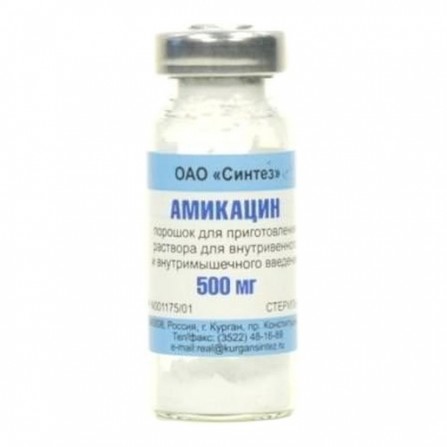Amikacin sulfate powder lyophilisate for injection 500mg
Condition: New product
1000 Items
Rating:
Be the first to write a review!

More info
Active ingredients
Amikacin
Composition
Amikacin (in the form of sulfate) 500 mg.
Pharmacological effect
After the / m injection is quickly and completely absorbed. Distributed in all tissues of the body. Plasma protein binding is low (0-10%). Gets through a placental barrier. It is not metabolized. Excreted in the urine unchanged. T1 / 2 - 2-4 h.
Pharmacokinetics
Semisynthetic antibiotic of the broad-spectrum aminoglycoside group. It has a bactericidal effect. Actively penetrating the cell membrane of bacteria, irreversibly binds to the 30S subunit of bacterial ribosomes and, thus, inhibits protein synthesis of the pathogen. Highly active against aerobic gram-negative bacteria: Pseudomonas aeruginosa, Escherichia coli, Shigella spp., Salmonella spp., Klebsiella spp., Enterobacter spp., Serratia spp., Providencia stuartii. (including strains resistant to penicillin, methicillin, some cephalosporins), some strains of Streptococcus spp. Inactive against anaerobic bacteria.
Indications
Infectious and inflammatory diseases of the severe course caused by microorganisms sensitive to amikacin: peritonitis, sepsis, sepsis of newborns, CNS infections (including meningitis), infections of bones and joints (including osteomyelitis), endocarditis, pneumonia, pleural empyema , lung abscess, purulent infections of the skin and soft tissues, infected burns, often recurrent urinary tract infections, infections of the biliary tract.
Contraindications
Severe renal dysfunction, acoustic neuritis, pregnancy, hypersensitivity to aminoglycoside antibiotics.
Use during pregnancy and lactation
Amikacin is contraindicated in pregnancy. If necessary, use during lactation should decide on the termination of breastfeeding.
Dosage and administration
Set individually, taking into account the severity of the course and localization of the infection, the sensitivity of the pathogen. Enter in / m, it is also possible in / in the introduction (jet for 2 minutes or drip). V / m or in / in adults and adolescents - 5 mg / kg every 8 hours or 7.5 mg / kg every 12 hours for 7-10 days. For children, the initial dose is 10 mg / kg, then 7.5 mg / kg every 12 hours. Maximum doses: for adults, the daily dose is 1.5 g.
Side effects
On the part of the digestive system: increased activity of hepatic transaminases, hyperbilirubinemia, nausea, vomiting. Allergic reactions: skin rash, itching, fever; rarely - angioedema.From the hemopoietic system: anemia, leukopenia, granulocytopenia, thrombocytopenia. On the part of the nervous system: headache, drowsiness, impaired neuromuscular transmission, hearing loss, including the development of irreversible deafness, vestibular disorders. On the part of the urinary system: oliguria, proteinuria, microhematuria; rarely - renal failure.
Interaction with other drugs
The risk of nephrotoxic action increases with simultaneous use of amikacin with amphotericin B, vancomycin, methoxyflurane, enflurane, NSAIDs, radiopaque agents, cefalotin, cyclosporine, cisplatin, polymyxinins. acid), cisplatin. When used concurrently with penicillins (in case of renal failure), the antimicrobial effect is reduced. At the same time Hinnom application with ethyl ether and neuromuscular blocker increases the risk of transmission of oppression dyhaniya.Amikatsin incompatible in solution with penicillins, cephalosporins, amphotericin B, chlorothiazide, erythromycin, heparin, nitrofurantoin, thiopentone as well, depending on the composition and concentration of the solution, - with tetracyclines, B vitamins, vitamin C and potassium chloride.
special instructions
With caution used in patients with myasthenia and parkinsonism, as well as in the elderly. Patients with impaired renal excretory function require correction of the dosing regimen, depending on the values of QC. Amikacin is not recommended for patients with hypersensitivity to other aminoglycosides because of the risk of cross-allergy. The risk of ototoxic and nephrotoxic effects increases with the use of amikacin in high doses or in predisposed patients.


